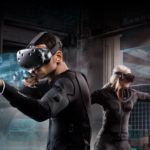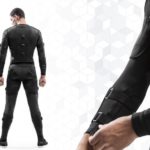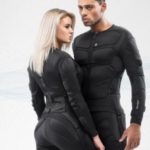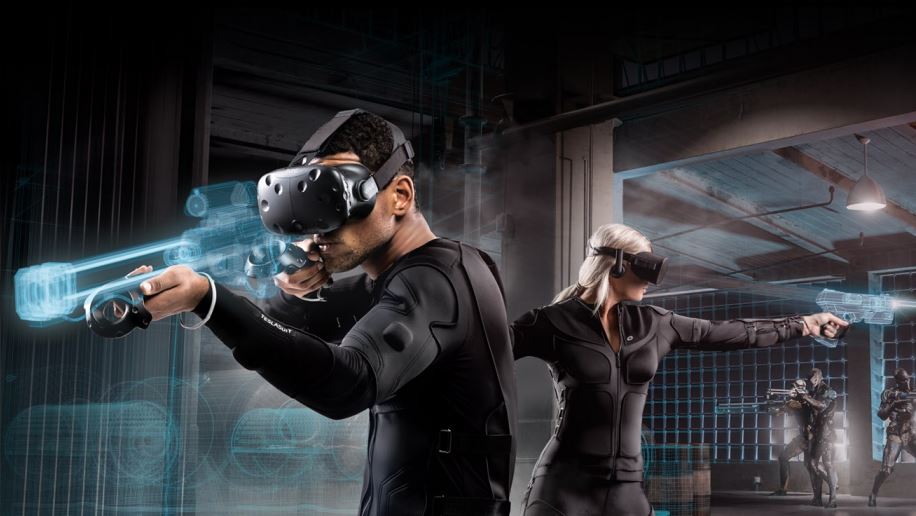
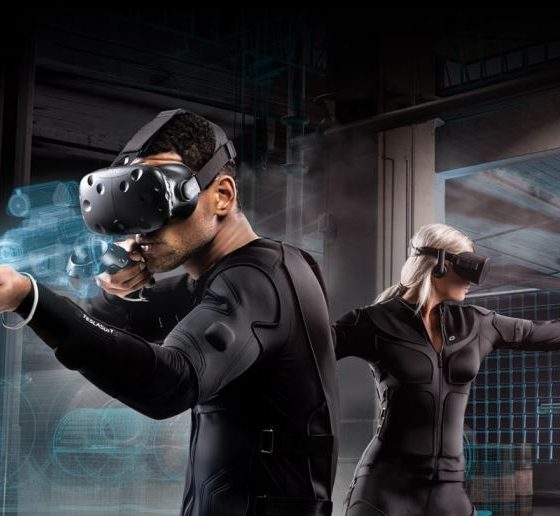
News
Virtual reality haptic “smart suit” uses AI with biometrics to simulate real-world environments
One of the innovative future technologies that was on display at this year’s Consumer Electronics Show (CES 2019) in Las Vegas is the Teslasuit, a full body virtual reality haptic suit that delivers real sensations to users that mimic the environment of a digital simulation or game. In a haptic feedback system, stimuli are used to provoke real sensations involving touch – shocks, punches, pushes, bumps, etc. Teslasuit combines this sort of environmental feedback along with climate control, motion capture, and biometric systems to give a fully responsive, immersive experience to the user. Combined with true-to-life virtual reality graphics, this device could finally provide the experience VR was intended to have since its development began.
The full-body sensations of the Teslasuit seem to indicate a new level of experience for virtual reality users, but the haptic capabilities aren’t the only things making it stand out. The suit’s biometric system is designed to use machine learning to analyze heart rate, stress levels, and overall mental and emotional states to create experiences catered to the user. How this capability will be implemented is really up to game developers, though. As data is gathered from biometrics, capabilities will follow. “This is very important for the gaming industry. We see that in the future, when we come to the end user market, that we will be able to offer a lot of data sensing for the developers to process, for the AI itself to adjust the game to the player,” Dimitri Mikhalchuk, co-founder of Teslasuit, explained in an interview with Digital Trends. The suit was first officially unveiled at CES 2018.
Teslasuit uses 68 channels embedded throughout the suit’s fabric to deliver electrical stimulations, and the company is working to expand on that number. Also included in the suit’s software is a haptic library, enabling game developers to create their own effects to correspond with their virtual worlds. The climate control system adjusts the temperature of the suit, heating and cooling in accordance with the virtual environment. Finally, its motion capture and avatar system track motions from the users entire body to interact with virtual environments (and built with multiple players in mind), something that’s more or less an expansion on the core of VR to begin with.
- The haptic Teslasuit as imagined in a VR game environment. | Credit: Teslasuit
- The haptic Teslasuit. | Credit: Teslasuit
- The haptic Teslasuit. | Credit: Teslasuit
While the Teslasuit brings virtual worlds closer to a potentially action-packed reality, bruises are not part of the experience, according to Mikhalchuk. The electric stimulation is matched to the users own strength, adapting its responses to the input. In other words, the force a user “hits” with in a game is the amount of force used to “hit” back, i.e., electric pulses make the muscles contract within that range.
With the equivalent of a full body shocking device wrapped around players, the question of security arises, yet another thing Teslasuit has addressed in its design. Its software has military grade encryption (AES 256) built into its wireless control system to ensure users’ bodies are not (literally) hacked into. Among its many features, Teslasuit is also completely wireless, boasts a 10+ hour battery life, and is machine washable (important for sweat-inducing virtual scenarios and general funk from frequent wear). A summary of the device on the Teslasuit website reads like something from a science fiction movie:
A highly developed form of computer modeling allows an operator to immerse in the artificial world. The user can act directly in it with the help of special sensory devices that link movements with audio-visual effects. In this case, the user’s visual, auditory, tactile, and motor sensations are replaced by their imitation, generated by a computer system with full body haptic VR suit. At the same time, biometric system of the Teslasuit analyzes human performance and health (workforce and human performance analytics). – Teslasuit.io
The future of augmented reality and virtual reality applications have been explored in fictional storylines over the years with the most recent and directly relevant one being the haptic system imagined in the movie Ready Player One. The Battlestar Galactica prequel series “Caprica” also imagined an immersive virtual world that users could “feel” experiences in (or otherwise do things they wouldn’t/couldn’t in the real world), but that didn’t require a suit, just a mind. In an episode of Netflix’s Black Mirror series called “Playtest”, an American traveler in the UK signs up to demo an immersive VR horror game to earn some money. Unlike the Teslasuit, however, the experience in that episode involved an implant to the user’s neck called a “mushroom” which linked up the VR experience with a user’s brain. The Matrix also suggested an immersive environment, although people weren’t exactly voluntarily involved, if they ever knew it wasn’t real to begin with.
Other than gaming, Teslasuit is suggestive of several solutions for non-entertainment industries. According to an article on their company website, several VR-training solutions were available for demonstration at CES 2019: Astronaut VR-training in an ISS module, an oil-loading ramp operation VR-simulator, emergency evacuation VR-training, and a powerplant VR training simulator. Teslasuit is currently continuing its outreach and collaboration with game companies to develop content. Its software development kit and corresponding system tools and applications are included with the purchase of the suit which began shipping B2B in the third quarter of 2018.
Watch the below video for a first-hand review of Teslasuit:

Elon Musk
Elon Musk and Tesla AI Director share insights after empty driver seat Robotaxi rides
The executives’ unoccupied tests hint at the rapid progress of Tesla’s unsupervised Robotaxi efforts.

Tesla CEO Elon Musk and AI Director Ashok Elluswamy celebrated Christmas Eve by sharing personal experiences with Robotaxi vehicles that had no safety monitor or occupant in the driver’s seat. Musk described the system’s “perfect driving” around Austin, while Elluswamy posted video from the back seat, calling it “an amazing experience.”
The executives’ unoccupied tests hint at the rapid progress of Tesla’s unsupervised Robotaxi efforts.
Elon and Ashok’s firsthand Robotaxi insights
Prior to Musk and the Tesla AI Director’s posts, sightings of unmanned Teslas navigating public roads were widely shared on social media. One such vehicle was spotted in Austin, Texas, which Elon Musk acknowleged by stating that “Testing is underway with no occupants in the car.”
Based on his Christmas Eve post, Musk seemed to have tested an unmanned Tesla himself. “A Tesla with no safety monitor in the car and me sitting in the passenger seat took me all around Austin on Sunday with perfect driving,” Musk wrote in his post.
Elluswamy responded with a 2-minute video showing himself in the rear of an unmanned Tesla. The video featured the vehicle’s empty front seats, as well as its smooth handling through real-world traffic. He captioned his video with the words, “It’s an amazing experience!”
Towards Unsupervised operations
During an xAI Hackathon earlier this month, Elon Musk mentioned that Tesla owed be removing Safety Monitors from its Robotaxis in Austin in just three weeks. “Unsupervised is pretty much solved at this point. So there will be Tesla Robotaxis operating in Austin with no one in them. Not even anyone in the passenger seat in about three weeks,” he said. Musk echoed similar estimates at the 2025 Annual Shareholder Meeting and the Q3 2025 earnings call.
Considering the insights that were posted Musk and Elluswamy, it does appear that Tesla is working hard towards operating its Robotaxis with no safety monitors. This is quite impressive considering that the service was launched just earlier this year.
Elon Musk
Starlink passes 9 million active customers just weeks after hitting 8 million
The milestone highlights the accelerating growth of Starlink, which has now been adding over 20,000 new users per day.

SpaceX’s Starlink satellite internet service has continued its rapid global expansion, surpassing 9 million active customers just weeks after crossing the 8 million mark.
The milestone highlights the accelerating growth of Starlink, which has now been adding over 20,000 new users per day.
9 million customers
In a post on X, SpaceX stated that Starlink now serves over 9 million active users across 155 countries, territories, and markets. The company reached 8 million customers in early November, meaning it added roughly 1 million subscribers in under seven weeks, or about 21,275 new users on average per day.
“Starlink is connecting more than 9M active customers with high-speed internet across 155 countries, territories, and many other markets,” Starlink wrote in a post on its official X account. SpaceX President Gwynne Shotwell also celebrated the milestone on X. “A huge thank you to all of our customers and congrats to the Starlink team for such an incredible product,” she wrote.
That growth rate reflects both rising demand for broadband in underserved regions and Starlink’s expanding satellite constellation, which now includes more than 9,000 low-Earth-orbit satellites designed to deliver high-speed, low-latency internet worldwide.
Starlink’s momentum
Starlink’s momentum has been building up. SpaceX reported 4.6 million Starlink customers in December 2024, followed by 7 million by August 2025, and 8 million customers in November. Independent data also suggests Starlink usage is rising sharply, with Cloudflare reporting that global web traffic from Starlink users more than doubled in 2025, as noted in an Insider report.
Starlink’s momentum is increasingly tied to SpaceX’s broader financial outlook. Elon Musk has said the satellite network is “by far” the company’s largest revenue driver, and reports suggest SpaceX may be positioning itself for an initial public offering as soon as next year, with valuations estimated as high as $1.5 trillion. Musk has also suggested in the past that Starlink could have its own IPO in the future.
News
NVIDIA Director of Robotics: Tesla FSD v14 is the first AI to pass the “Physical Turing Test”
After testing FSD v14, Fan stated that his experience with FSD felt magical at first, but it soon started to feel like a routine.

NVIDIA Director of Robotics Jim Fan has praised Tesla’s Full Self-Driving (Supervised) v14 as the first AI to pass what he described as a “Physical Turing Test.”
After testing FSD v14, Fan stated that his experience with FSD felt magical at first, but it soon started to feel like a routine. And just like smartphones today, removing it now would “actively hurt.”
Jim Fan’s hands-on FSD v14 impressions
Fan, a leading researcher in embodied AI who is currently solving Physical AI at NVIDIA and spearheading the company’s Project GR00T initiative, noted that he actually was late to the Tesla game. He was, however, one of the first to try out FSD v14.
“I was very late to own a Tesla but among the earliest to try out FSD v14. It’s perhaps the first time I experience an AI that passes the Physical Turing Test: after a long day at work, you press a button, lay back, and couldn’t tell if a neural net or a human drove you home,” Fan wrote in a post on X.
Fan added: “Despite knowing exactly how robot learning works, I still find it magical watching the steering wheel turn by itself. First it feels surreal, next it becomes routine. Then, like the smartphone, taking it away actively hurts. This is how humanity gets rewired and glued to god-like technologies.”
The Physical Turing Test
The original Turing Test was conceived by Alan Turing in 1950, and it was aimed at determining if a machine could exhibit behavior that is equivalent to or indistinguishable from a human. By focusing on text-based conversations, the original Turing Test set a high bar for natural language processing and machine learning.
This test has been passed by today’s large language models. However, the capability to converse in a humanlike manner is a completely different challenge from performing real-world problem-solving or physical interactions. Thus, Fan introduced the Physical Turing Test, which challenges AI systems to demonstrate intelligence through physical actions.
Based on Fan’s comments, Tesla has demonstrated these intelligent physical actions with FSD v14. Elon Musk agreed with the NVIDIA executive, stating in a post on X that with FSD v14, “you can sense the sentience maturing.” Musk also praised Tesla AI, calling it the best “real-world AI” today.
